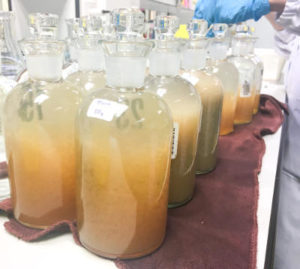What is BOD?
The biological oxygen demand (BOD) is also called biochemical oxygen demand. The BOD refers to the amount of oxygen required for the biotic degradation of organic matter in bodies of water.
The BOD is a pollution parameter mainly to asses the quality of effluent or wastewater. Untreated wastewater has usual a high oxygen demand. Are the impurities organic material or aerobic organism, the wastewater has a biological oxygen demand, BOD. Industrial wastewater tends to a higher chemical oxygen demand, COD caused by dissolved chemicals or pollutants from washing processes. Both BOD or COD requires a lot of dissolved oxygen from the water. The significance of BOD is very clear. If oxygen is used from organic impurities, it cant be used by other creatures living in the water.
Drinking water is tested as well to check, if there is any organic matter present. To evaluate drinking water, the TOC - Total Organic Carbon is meassured, instead of the biochemical oxygen demand. This TOC methode is faster and can be done with an electronic device. Whereas the methode to measure the biochemical oxygen demand takes several days to get results.
Who demands this oxygen?

The biochemical decomposition of organic substrates is carried out by microorganism. For this work the bacteria need energy. Aerobic bacteria, that do this work, need dissolved oxygen to produce energy. This oxygen is consumed in this process and the DO level in the water get less. If there is a lot of organic material present in the water, the oxygen demand is correspondingly high to carry out the decomposition. This oxygen is then lacking the plants and animals that also live in this water.
The water quality is controlled by the authorities to protect users form health and other adverse effects of poor water quality. A high BOD level can indicate the existence of faecal contamination. Or particulate and dissolved organic carbon from various sources, neither from human nor from animal. This kind of contamination can seriously affect human health and cause problems to the industry.
It is very important for every government to ensure a low BOD level in the effluent water leaving a sewage plant. As it is in public interest to have rivers, lakes and seas with a high level of dissolved oxygen. A low biochemical oxygen demand ensures that the dissolved oxygen is not only consumed by organisms from the wastewater. But that there is enough oxygen left for fish and plants.
To achieve this common goal, international agreements have been reached. Such as the Resolution II and the detailed plans of the UN, made after the United Nations Water Conference.
How to measure the BOD level?
The conditions and the time how this testing is done is set and standardized, by the authorities. There are two methods to measure the BOD level. Both methods are empirical tests.
- Method I: A sample of the water is kept at a constant temperature of 20°C in the dark. After a period of five days, the oxygen content is measured. In comparison to the original value, the oxygen consumption during the measurement period indicates the oxygen demand in the water.
- Method II: If a very high BOD is to be expected or if other toxic or inhibitory substances are present in the water, the sample can be diluted at the beginning. In this way it can be prevented that too little oxygen is present to break down the organic substances. This would falsify the measurement result. As with method 1, a comparison of the before and after values now serves as a measure of oxygen consumption during the measurement period.
After the 5th day the remaining dissolved oxygen in the water sample is measured. With this oxygen the BOD level can be calculated.
Drinking water should have after 5 days a BOD of well below 1 mg/l. Acceptable wastewater from a sewage treatment plant should have a BOD of around 20 mg/l.
As those methods are empirical the BOD indicator gives no absolute results. The indicator provides a good comparison among samples but it gives no exact measure of the contamination in the water. An alternative indicator to BOD is COD – Chemical Oxygen Demand.
Anaerobic bacteria, such as SRB, don't need dissolved oxygen in the water to survive. Such microorganism is living on sulfur instead of oxygen, hence they can't be detected by measuring the biochemical oxygen demand.
